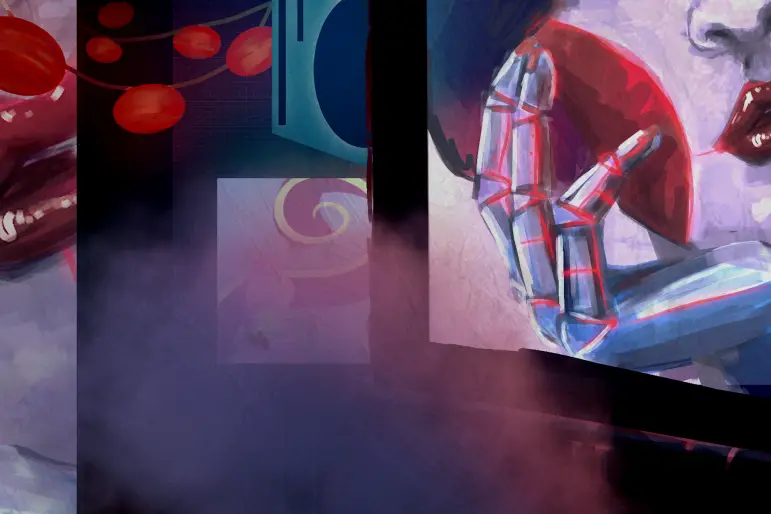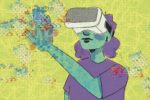When someone thinks of cyberpunk, a clear image comes to mind. Whether it’s “Blade Runner,” Cyberpunk 2077 or “Neuromancer” we draw inspiration from, this dystopian genre immediately evokes imagery of densely packed chrome structures and fluorescent lights standing against a dark night sky.
And, almost without fail, this landscape also includes elements of East Asian cultures. Our bodies, our languages, our clothing, you name it. Orientalism is almost as pervasive in cyberpunk as the technology that inspired it.
There is, as with all things, a historical explanation as to why this is the case. Speculative fiction has always reflected modern fears, so cyberpunk is not just any version of cybernetic, action-packed entertainment. It is also a reflection of American cultural anxieties that have yet to fade away.
While the word “orientalism” came from Edward Said’s critique of the biased depictions of Asia during the age of imperialism, the prejudice itself refused to stay within the confines of classic art and literature. In regard to cyberpunk media, the study of orientalism evolved into scholarship that focuses on the portrayal of East Asians in science fiction and how that rose from the economic and political contexts of the 1980s and beyond.
In the 1980s, Japan’s rapid economic growth competed with that of America’s. Americans were worried that Japan would eventually overcome the U.S. as an economic powerhouse and that Japanese immigrants would take American jobs. China’s rapid development began soon after Japan’s, as did the Asian “tigers.” China’s growth placed it neck-and-neck with the United States in the struggle for political and economic dominance. Subsequently, American media and foreign policy began to stress China’s presence on the world stage like never before.
These fears motivated both violent hate crimes against East Asian communities and a widespread fascination with East Asia itself. As narratives about an East Asian economic and technological “takeover” influenced the American way of thinking, they also began to seep into the entertainment we create.
The result? A cybernetic spin on orientalism, appropriately dubbed “techno-orientalism.” This trend strikes me as nebulous in the same way orientalism does. Though likely appreciative in its intent, techno-orientalism perpetuates age-old stereotypes about East Asians: our status as an eternal outsider, our supposed impassivity and our alleged alignment with powerful and exploitative structures.
Dazzling shots of disorienting bright neon signs emblazoned with kanji amid the curved rooftops of busy night markets or silver skyscrapers point to the exotification of East Asian urban life. Moreover, the conflation of Japanese and Chinese artifacts are symptoms of the perception of Asian countries as a homogenous (and often antagonistic) entity.
Other times, techno-orientalism comes in the form of white characters wearing East Asian clothing, from Joi’s qipao in “Blade Runner 2049” to the slick samurai iconography in the background of Cyberpunk 2077. Regardless of the setting, cyberpunk videogames, shows and comics use East Asian cultural markers to establish that a setting is supposed to be dystopian or outlandish. This is no simple coincidence, either; William Gibson, the writer of “Neuromancer,” notably said, “Modern Japan simply was cyberpunk.”
(White) American creators choose distinctly East Asian visuals because they’re supposed to look futuristic and strange to modern audiences. While this might partly be out of an attempt at cultural appreciation, nothing changes the fact that the cultural influences are basically used as props for white leads and an easy shorthand for something “other.” Techno-orientalism reduces East Asians to either a backdrop or an enemy, but either way, our existence is treated as something to either fetishize or demonize. Sometimes both.
In cyberpunk, a dystopian future is an Asian future. Ultimately, these visuals exist to distance the world from the audience, thus reinforcing the orientalist practice of removing the observer from the observed. It’s just another way to treat East Asian cultures as something exotic and otherworldly, which contributes to fetishization and reinforces stereotypes.
Furthermore, in America, these stories are told primarily by Americans, for Americans. It’s easy to go through a list of cyberpunk games, novels and movies (though more so the latter two) with stories that lack input from any Asian creatives. Therefore we see little nuance in the portrayals of Asian communities regardless of how sincere and well-developed the stories themselves might be.
Any Asianness that cyberpunk settings borrow is never justification enough to actually feature East Asian characters or cultures as anything more than a prop for the predominantly white leads. Remakes of cyberpunk movies and shows, if made with an American audience in mind, will whitewash characters who were originally Asian or Asian-coded. And even when cyberpunk media includes Asian characters, those characters still lack agency. Instead of being people in their own right, they are relegated to certain “yellow peril” tropes, only this time with a slightly futuristic edge.
Techno-orientalism is also dangerous to cyberpunk stories themselves. The genre is inherently political, as it is rooted in criticism against exploitation. It is a fiction that looks closely at the power of mega-corporations, the potentially dehumanizing effects of technology and the gritty realities of inequality that exist in a hyper-competitive world. Though there is nothing inherently racist about this, the use of East Asian backgrounds, both in settings and characters, muddles that critique.
Techno-orientalism makes it easy for creators and audiences to miss the larger message in exchange for a convenient scapegoat of East Asians as job-thieves, corrupt money-making machines or something more technologically aligned than truly human. “The Orient” becomes a sinister, creeping and exploitative force against Western freedom. If any of that sounds familiar, it might be because similar rhetoric has always been used against us.
None of this means we have to condemn the genre entirely, nor do we have to strip it bare of any East Asian influences. It would be reductive to do so, anyway, when the genre has taken root so well in East Asian media (especially anime and Japanese video games) and when globalization makes cultural diffusion nearly unavoidable. Some of cyberpunk’s influences directly come from the natural evolution of art and genuine cultural appreciation, and that’s all well and good.
So, lucky for us, art is never static. As people grow more self-aware about the media around them, Asian content creators have also grappled with techno-orientalism and come to make cyberpunk stories that reject problematic tropes while embracing their own cultures. Asian tabletop roleplaying game (TTRPG) creators started “The Cyberpunk by Asian Creators Game Jam,” which was designed to showcase cyberpunk games that subvert or otherwise dodge the cultural fetishization rampant in other TTRPGs.
Not only that, but cyberpunk works made in Asia, such as the Singaporean “Chinatown Detective Agency,” accurately and respectfully represent the places and cultures they are trying to depict. Obviously, because these works aren’t made with an America-centric lens, they’re able to circumvent many harmful techno-orientalist tropes.
Non-Asian creators are more than welcome to do the same thing. After all, nothing is more antithetical to cyberpunk than policing other people’s creative efforts. But creators should be aware of any biases they put into their art and ask themselves why they feel so compelled to code specific cultures as abnormal or dangerous. They should also think seriously about why they feel so compelled to draw from Asian visuals while excluding Asian voices and characters, and why they need to remove Asian cultural iconography from its greater context instead of appropriately incorporating it into their world-building. And if we could see East Asian aesthetics for East Asians instead of a predominantly white cast and audience, well, that’d be great too.
Cyberpunk started out as a fascinating way to envision a globalized and technologically advanced future while also criticizing corrupt power structures and engaging in philosophical musings about the nature of humanity. Despite its powerful association with orientalism, there’s no reason why we can’t return to what cyberpunk should have always been.

















